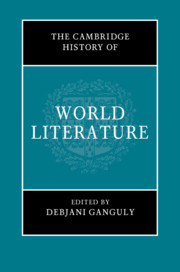Book contents
- The Cambridge History of World Literature
- The Cambridge History of World Literature
- Copyright page
- Contents
- Figures
- Contributors
- Acknowledgements
- Introduction
- Part I Genealogies
- 1 Ancient World Literature
- 2 The Silk Roads of World Literature
- 3 Arabic Literary Prose, Adab Literature, and the Formation of Islamicate Imperial Culture
- 4 Worldmaking and Early Modernity: Cartographic Poesis in Europe and South Asia
- 5 Colonial Philology and the Origins of World Literature
- 6 Globalism’s Prehistory: Technologies of Modernism
- 7 After 1945: Holocaust Memory, Postcoloniality, and World History
- 8 World Literature after 1989: Revolutions in Motion
- Part II Thinking the World
- Part III Transregional Worlding
- Part IV Cartographic Shifts
- Part V World Literature and Translation
- Part VI Poetics, Genre, Intermediality
- Part VII Scales, Polysystems, Canons
- Part VIII Modes of Reading and Circulation
- Part IX The Worldly and the Planetary
- Index
- References
2 - The Silk Roads of World Literature
from Part I - Genealogies
Published online by Cambridge University Press: 17 August 2021
- The Cambridge History of World Literature
- The Cambridge History of World Literature
- Copyright page
- Contents
- Figures
- Contributors
- Acknowledgements
- Introduction
- Part I Genealogies
- 1 Ancient World Literature
- 2 The Silk Roads of World Literature
- 3 Arabic Literary Prose, Adab Literature, and the Formation of Islamicate Imperial Culture
- 4 Worldmaking and Early Modernity: Cartographic Poesis in Europe and South Asia
- 5 Colonial Philology and the Origins of World Literature
- 6 Globalism’s Prehistory: Technologies of Modernism
- 7 After 1945: Holocaust Memory, Postcoloniality, and World History
- 8 World Literature after 1989: Revolutions in Motion
- Part II Thinking the World
- Part III Transregional Worlding
- Part IV Cartographic Shifts
- Part V World Literature and Translation
- Part VI Poetics, Genre, Intermediality
- Part VII Scales, Polysystems, Canons
- Part VIII Modes of Reading and Circulation
- Part IX The Worldly and the Planetary
- Index
- References
Summary
Ideas, motifs, aesthetics, bodies of knowledge, texts, genres and literary worlds have travelled for centuries along Silk Road’s multiple networks of circulation connected through myriad contact hubs located across many temporal and spatial planes. This chapter argues that the Silk Road offers a roadmap for thinking about modes of circulation in world literature in ways that take us beyond the linear trajectory of West influencing the East, the centrifugal proliferation of the European novel around the world, the centripetal East coming to the West for a place, and the single temporality of the global visions of “modern” “colonial” and “postcolonial” “planetarity,” “globalization.” It offers two examples. The 1001 Nights is a classic example of the global circulation of a “text” beyond “translation-as-circulation” and the confines of monologically defined language, nation, genre and historical period. Coffee is a site of global connectedness and intercultural exchange in a comparative analysis of coffee in five literary works from Egypt, Japan, Palestine, Taiwan and Turkey. The global pasts of coffee give shape to the literary world and worldliness; however, each is uniquely mapped by the itinerary of coffee and the cultures it has picked up on the way.
- Type
- Chapter
- Information
- The Cambridge History of World Literature , pp. 63 - 79Publisher: Cambridge University PressPrint publication year: 2021

